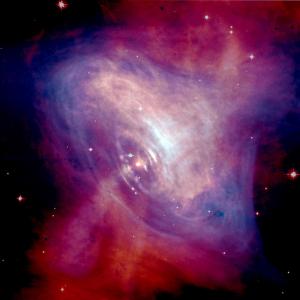Gravitational wave scientists set their sights on dark matter
2 Oct 2023 10:50:43 UTC
Topic 230154
(moderation:
Language
Copyright © 2024 Einstein@Home. All rights reserved.


This is a quite interesting
)
This is a quite interesting use of GW detectors and certainly a novel idea for GEO. The idea is that a scalar matter field will tend to gravitationally attract, and in turn be attracted by, the ordinary matter that we are familiar with. The quantum of this field would be a very light, spin zero, boson with positive ( ie. reinforcing ) self interactions. It is thought that dark matter has helped in the formation of galaxies and now exists as a halo around most galaxies. I'd never heard of the term 'dark photon' until now and I believe this refers to such a boson.
{ I recall in my visit to Hanover in 2011 a short tour of the GEO facility kindly allowed by Hartmut Grote who showed us the corner station optics now being referred to here. He is one of the main authors of this paper. }
Now the GEO/Cardiff/Glasgow teams have as their analysis a supposed coupling with electromagnetic entities - specifically electrons and photons - in a fashion that would affect both the beam splitter and the mirrors of a two arm interferometer. The dominant effect is on the beam splitter and would manifest as an effective change in the electron mass and the fine structure constant. The fine structure constant determines the strength of the EM influences in a system. So this field would actually change the lattice spacing of the interferometer's materials. Anyway the width of the beam splitter mirror would jitter as a scalar wave passes by and thus induce a change in the optical path lengths of each arm differently. This then manifests itself in the dark port output. Detection of the signal of interest is assisted by the use of 'squeezed light', which is in reality directing noise to a non-interesting quadrature. Curiously GEO would be the most sensitive of all the current GW detectors to this phenomenon. The frequency of this disturbance would reveal the local density of this type of dark matter. Their analysis found no such effect but set upper bounds for it that may be looked at with other ( future ) devices.
{ I must say this has some 'echoes' of the aether wind experiments of the late 1800s : the possibility of the matter field travelling along with the Earth, the change in the optical properties with respect to Earth's dynamics and an ( almost Lorentzian ) change in the mirror dimensions. Different posited mechanisms for sure but I couldn't help but notice some superficial analogy. Either that or I've read the paper wrong. }
Cheers, Mike.
( edit ) I did read it wrong, on further reading the scalar field here is not referring to 'dark photons', whatever they are.
I have made this letter longer than usual because I lack the time to make it shorter ...
... and my other CPU is a Ryzen 5950X :-) Blaise Pascal